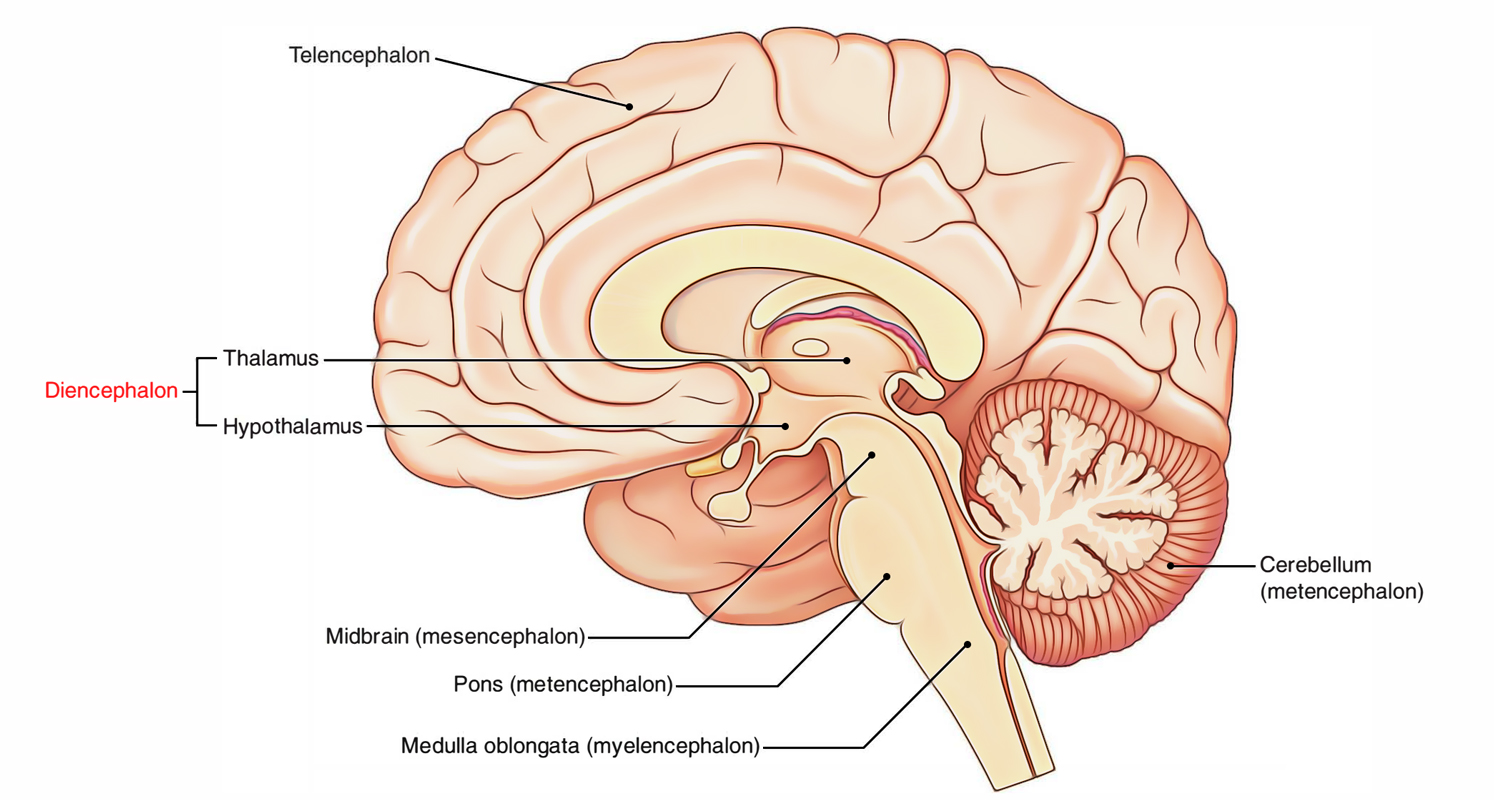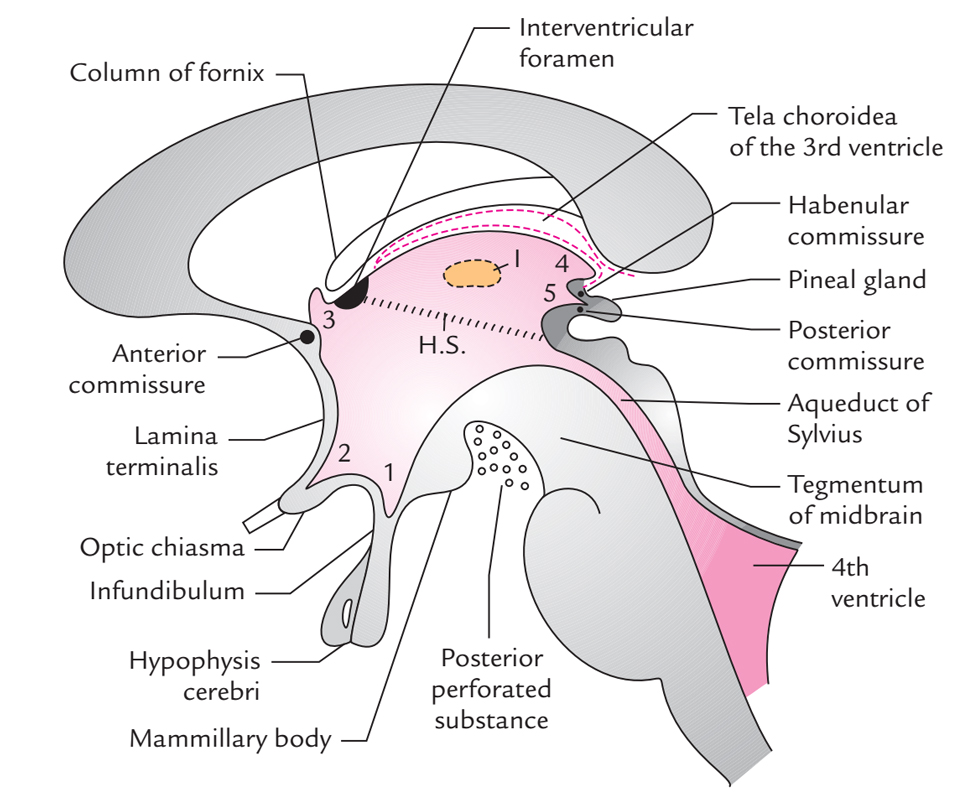The diencephalon is a part of brain situated cranial to the midbrain and is more or less totally encompassed by the cerebrum. At the base of the brain in the region of interpeduncular fossa, is the only part of diencephalon that is exposed to the surface. 3rd ventricle is the cavity inside the diencephalon. It conveys on either side together with the lateral ventricle of the cerebral hemisphere. The primary elements of the diencephalon are as follows:
- Thalamus.
- Hypothalamus.
- Metathalamus.
- Epithalamus.
- Subthalamus.

Diencephalon
Divisions and Subdivisions
Pars dorsalis and pars ventralis are the 2 major parts diencephalon is split into. These subdivisions are divided from every other by a shallow groove, the hypothalamic sulcus, which goes from interventricular foramen to the rostral end of the cerebral aqueduct of the midbrain and are viewed in midsagittal view of the brain.

Diencephalon: Divisions
Pars dorsalis is located above (dorsal) the hypothalamic sulcus and is composed of: thalamus, metathalamus and Cepithalamus.
Pars ventralis is located below (ventral) the hypothalamic sulcus and is composed of: subthalamus and hypothalamus.
Hence the diencephalon is split into 5 parts:
- thalamus
- metathalamus
- epithalamus
- subthalamus
- hypothalamus
Every of these parts have additional subsections.
Divisions and subsections of the diencephalon
| Divisions | Subdivisions |
|---|---|
| Pars dorsalis | |
| • Thalamus (dorsal thalamus) | |
| • Metathalamus | Medial and lateral geniculate bodies |
| • Epithalamus | Pineal gland, habenular Nuclei and commissure, and posterior commissure |
| Pars ventralis | |
| • Subthalamus (ventral thalamus) | Subthalamic nucleus and zona inserta |
| • Hypothalamus | |
Thalamus
The thalamus (thal’-ah-mus) consists of two lateral masses of nervous tissue that are joined by a narrow isthmus of nervous tissue called the interthalamic adhesion. Sensory nerve impulses (except those for smell) coming from lower regions of the brain and the spinal cord are first received by the thalamus before being relayed to the cerebral cortex. The thalamus provides a general but nonspecific awareness of sensations such as pain, pressure, touch, and temperature. It seems to associate sensations with emotions but it is the cerebral cortex that interprets the precise sensation. The thalamus also serves as a relay station for communication between motor areas of the brain.
Hypothalamus
The hypothalamus (hi-po-thal i-ah-mus) is located inferior to the thalamus and anterior to the midbrain. It communicates with the thalamus, cerebrum, and other parts of the brain. The hypothalamus is the major integration center for the autonomic nervous system. In this role, it controls virtually all internal organs. The hypothalamus also is the connecting link between the brain and the endocrine system, which produces chemicals (hormones) that affect most cells in the body. This link results from hypothalamic control of the hypophysis, or pituitary gland, which is suspended from its inferior surface. Although it is small, the hypothalamus exerts a tremendous impact on body functions.
The primary function of the hypothalamus is the maintenance of homeostasis, and this is accomplished through its regulation of
- body temperature;
- mineral and water balance;
- appetite and digestive processes;
- heart rate and blood pressure;
- sleep and wakefulness;
- emotions; and
- secretion of hormones by the pituitary gland.
Metathalamus
The metathalamus is composed of 2 rounded medial and lateral geniculate bodies which protrude from the posteroinferior surface of the thalamus. The medial and lateral geniculate bodies create relay stations for the specific senses of hearing and eyesight, respectively.
Epithalamus
The epithalamus is a small area of diencephalon, posterosuperior to the thalamus. It is composed of pineal gland and habenular nuclei. The pineal gland plays a significant function in controlling the onset of puberty via its secretion. The decrease in pineal secretion precipitates puberty. The pineal gland is also involved in sleep-wake cycle. The habenular nuclei have olfactory and limbic connections. They may be affected by odor and are involved in psychological and visceral reactions to smells.
Subthalamus
The subthalamus is a small area of diencephalon that is located between the thalamus and the midbrain. It includes several nerve tracts and the subthalamic nuclei that are related to basal ganglia and are involved in controlling motor functions.

 (56 votes, average: 4.36 out of 5)
(56 votes, average: 4.36 out of 5)